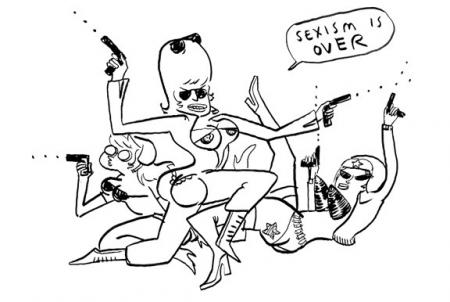Serendip is an independent site partnering with faculty at multiple colleges and universities around the world. Happy exploring!
hwink's blog

Queering Weakness: The Refusal of Strong Female Characters
Kate Beaton, creator of the webcomic “Hark! A Vagrant”, in collaboration with two other cartoonists, Meredith Gran and Carly Monardo, created a small series of comics called “Strong Female Characters”. In the author’s notes on her site, Beaton comments:
“We are professionals in the entertainment industry and we think we know what we are talking about when we say that there needs to be more strong female characters out there and we know just what to do about it. Finally, some women to look up to!”


Lipstick on a Pit Bull and the Woman in the Pantsuits
http://www.hulu.com/watch/34465/saturday-night-live-palin--hillary-open
Sarah Palin is a fascinating figure that we have begun to talk about in this class, but I would like to explore more deeply the ways in which Sarah Palin’s political career was played out on the national stage and the feminist implications. The figure of Sarah Palin-- as a woman, as a politician, as a joke-- captivated America throughout the 2008 campaigning season. Tina Fey’s portrayal of Palin, especially alongside her colleague Amy Poehler playing Hillary Clinton in one popular SNL clip, demonstrates some of the popular dialogue centering around women’s issues throughout the election. By contextualizing Palin’s impact as a woman on the political scene with Hillary Clinton’s presence, this Saturday Night Live sketch positions itself to examine the ways in which America negotiates a relationship to its female politicians. Poehler’s portrayal of Clinton alongside Tina Fey’s Palin serves to both contrast and align the women in regards to their treatment in popular media and public imagination.

Palin Mantrafesto
Sorry about lateness of posting! This is the Palin/bell hooks mantrafesto done by myself, mbeale, and sara.gladwin
Making feminism is a revolutionary act.
Revolutions of mindset can be violent.
Violence is an upheaval to oppression.

Mantrafesto
(group: rayj, amophrast, hwink)
If it’s possible, we have a responsibility to strive for it.
Striving for change inspires innovation.
Innovation may or may not be marketable.

Setting the Scene 4/3
This is the music video that Colleen Ryanne and I are planning to use to set the stage for class tomorrow! For future reference (or pre-class viewing if you're proactive like that).

Your Tongue is a Feminist
[edited 3/3/12 for formatting]
The feminism of the tongue is an inescapable idea of the trajectory of our course this semester. The tongue serves as a tripartite motif, representing three distinct but tightly interwoven branches. Food, language, and sex, especially sex that occurs between women, are all captured in the motif of the tongue. All three have been heavily represented in the feminist exploration through literature that is the project of our course, and the reasons for their consistent recurrence is the feminist nature of the tongue itself, with licking as a uniquely feminist mode of inquiry and understanding. I take as my primary example the text of Licking Belly by Gertrude Stein, but it is not the only example we have studied.

The Veil (as told by the girl who bought a copy of The Complete Persepolis for $15 on Amazon.com)

Female Relationships in Goblin Market
To me, the most striking thing about Rosetti's "Goblin Market" was the relationship between the women.
The relationship between Laura and Lizzie is complicated and intriguing; they are described as sisters but there is innuendo of sexual relationship. "Golden head by golden head" they sleep beside one another. Lizzie risks everything to help Laura, and succeeds in saving her. Maybe lovers, maybe sisters, one is undoubtedly the savior of the other. And the concluding lines of the poem do not chastise Laura for her indiscretion, but rather dispense the wisdom that "there is no friend like a sister." Regardless of its ambiguous nature, the poem centers on the fact of their relationship.
One of the things we didn't really talk about in class was Jeanie, the woman who fell prey to the goblins in the way that Laura did. Only, presumably, Jeanie did not have a Lizzie. Laura reflects on Jeanie when she realizes she can no longer hear the goblins, and the poem reads,
"She thought of Jeanie in her grave,
Who should have been a bride;
But who for joys brides hope to have
Fell sick and died"


